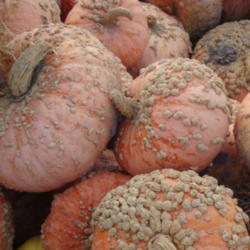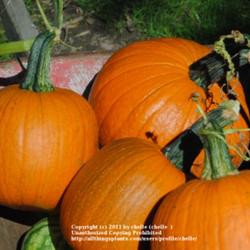By Dave Whitinger
One of the benefits of running your own business is that you're home all day, and one of the perks of being home is that you get to have lunch with the wife every afternoon. This afternoon, I posed the question to her as to which plant would be worthy of covering this month. After some thought, we realized the perfect plant to talk about in late fall is pumpkins! Well, more specifically,
winter squash.
The fruits we call pumpkins are actually a subset of a larger group of plants called winter squash. This group includes the butternuts, acorns and spaghetti squash you've surely seen in the grocery store, as well as the more than 1,000 other cultivars that are available to home gardeners.
For some reason that I don't fully understand, it seems that winter squash isn't eaten as commonly in the south as it is in the north and midwest, and that's a oversight I'm frequently working to correct. Having been born in Wisconsin, I was exposed to this tasty and hearty vegetable early in life, and I've grown them every year since. When Texans hear the word "squash," they usually think about the watery and tasteless yellow crooknecks and zucchini. Well, put those ideas out of your mind!
Squash is one of those "new world" vegetables that was unknown until trade between the continents began. The word derives from a native american word, askutasquash, which means something like "eat this raw." It's an annual fast growing vine that loves full sun, good soil, adequate moisture, and good drainage. As the vine grows, it makes new roots all along the way, until you end up with a massive "pumpkin patch" that draws up its soil needs from the entire bed. Given 90 days or so of good summer growing conditions, it offers an early reward of one or two fruits as a sampler. Once you pick those, it explodes into action, producing dozens of squashes per vine.

In the desert of southwestern Colorado, in ancient days, the
Anasazi (or "Ancient Pueblo People") lived in stone homes that they built directly into the walls under the sheer cliffs that adorned the high mesas on top of which they farmed. They drilled a fairly deep hole in the soil, dropped corn seed down, along with squash and bean seeds. These all grew together in a community we now refer to as "The Three Sisters," and in that harsh desert condition, they produced a bounty that gave them much leisure time to enhance their amazing
cliff houses.
The squash was surely an important staple of their diet, owing to its complex vegetable carbohydrates and dietary fiber. It's also an excellent source of vitamins A and C, potassium, omega-3 fatty acids, and much more. Is it a miracle food? I don't know about that, but it seems to be pretty nearly so.
We eat pumpkins during Thanksgiving, to honor the fruit's role in preserving the pilgrims as they established a foothold in the New World. A poem from the 1630s tells the story:
"Stead of pottage and puddings and custards and pies
Our pumpkins and parsnips are common supplies,
We have pumpkins at morning and pumpkins at noon,
If it were not for pumpkins we should be undoon."
As mentioned above, most people's only experience with squash comes from
zucchini,
yellow crooknecks,
butternuts,
acorns,
spaghetti squash, and pumpkins. The pumpkins around here seem to be only used for carving, and pie is made from something that comes in a can. Let's discard all those ideas and look past that, to the rich cornucopia that's available to us. The '
Green Striped Cushaw" is a beautifully ornamental large gourd that is perfect to adorn your porch this time of year. Enjoy it for a month or so, and then once winter starts to set in, open it up and cook it for dinner. (More on cooking it later.)
'
Tromba d'Albenga' is a butternut type, but the neck is thinner and much longer. It's a great conversation starter, and of course, is excellent to eat. One of my favorites, '
Jarrahdale', is a very large pumpkin type squash that can get to 20 pounds or more, with blue skin and and huge amounts of dense, sweet orange flesh. '
Galeux d'Eysines' is extremely warty and very tasty, and highly ornamental. Grow this one, displaying it in your kitchen until you can't wait any longer, then serve it for dinner.
'
Turk's Turban' is a fun one with lots of different colors on its skin, and on the blossom end it has a strange turban shape. Quite unusual. As you can imagine, many of these squashes have been bred to be ornamental, and this breeding work has only made them more palatable. If you're serving squash for dinner, why not place a few uncooked specimens on the table so your family can see what they are eating.
Well, what about actual "pumpkins"? Those big gourds you buy in the store are indeed winter squashes, but they have been bred for carving. That means they have a gigantic hollow area and very thin meat area. If you want to eat a pumpkin, get some old fashioned varieties like '
Sugar Pie' or '
Winter Luxury Pie.' These two are small 4 to 5 pound fruits with a tiny seed cavity. Nearly 90% of their weight is in the meat, and the taste can best be described as an intense pumpkin flavor. We grow these pumpkins for pie, of course, but more often than not we simply eat them like any other winter squash.
So, to cook any winter squash, cut it in half and place it with the cut side down into a pan that has a half inch of water. Stab the skin in several places to allow steam to escape, and cook the whole thing in the oven at 350 degrees for an hour or so. It's a lot like baking a potato: you'll know it's done because you press a fork into it and the fork goes all the way in without resistance.
Once you're at that point, remove the squash from the oven, and allow it to cool on the countertop. Then using a spoon, just scoop out all the meat. It'll have the consistency of watery baked potato. Fill up your bowls with this cooked meat, and then you can do what you want with it. We fill up ziplock bags with the stuff, and then freeze it in the chest freezer. When we're ready to eat it, we'll later pull a bag out, dump it into a pot, and cook it back to temperature. You can then add cinnamon, brown sugar, apple sauce, etc, to improve the flavor even more. As a side dish, it has no equal.
Our database of plants lists almost a thousand cultivars of squashes, and I highly recommend you check it out. Look at some the photos, read the comments, and pick out a few to grow. You can get seeds from any of the heirloom seed suppliers, especially
Victory Seed Company,
Baker Creek Heirloom Seeds,
Fedco Seeds, and many others. To see our database of squash, go to
our Squash and Pumpkins Database.

Dave is the Executive Director of National Gardening Association.

Victory Seed Company has all the seeds you want for your best garden in 2024.
For 25 years, the family-owned Victory Seed Company has provided the highest quality vegetable, herb and flower seeds to families across the country. We are passionate about providing you the best seeds available that give excellent germination, robust plants, and the harvest you want. With a catalog of over a thousand varieties, we have everything, and our prices are the kinds that we'd want to pay. We have hundreds of yesterday's heirloom vegetables, as well as today's award winning hybrid selections. Get to know us by visiting our website and browsing through our online vegetable seed catalog.

 In the desert of southwestern Colorado, in ancient days, the Anasazi (or "Ancient Pueblo People") lived in stone homes that they built directly into the walls under the sheer cliffs that adorned the high mesas on top of which they farmed. They drilled a fairly deep hole in the soil, dropped corn seed down, along with squash and bean seeds. These all grew together in a community we now refer to as "The Three Sisters," and in that harsh desert condition, they produced a bounty that gave them much leisure time to enhance their amazing cliff houses.
In the desert of southwestern Colorado, in ancient days, the Anasazi (or "Ancient Pueblo People") lived in stone homes that they built directly into the walls under the sheer cliffs that adorned the high mesas on top of which they farmed. They drilled a fairly deep hole in the soil, dropped corn seed down, along with squash and bean seeds. These all grew together in a community we now refer to as "The Three Sisters," and in that harsh desert condition, they produced a bounty that gave them much leisure time to enhance their amazing cliff houses. 
 Victory Seed Company has all the seeds you want for your best garden in 2024.
Victory Seed Company has all the seeds you want for your best garden in 2024.